分三階段進行的聯展
Part 1
signals … storms and patterns
瞬息 …… 風中序
3.18 – 5.28, 2023
Part 2
signals … folds and splits
瞬息 展與接
6.3 – 7.30, 2023
Part 3
signals … here and there
瞬息 彼/此
8.5 – 9.29, 2023
To initiate a new beginning for Para Site’s vision, ‘signals … 瞬息 ’ is an exhibition of newly commissioned and existing works presented in dialogue with an experimental display structure that will transform across a period of six months. Structured into three chapters, the first, ‘signals … storms and patterns’ (opening 17 March 2023), will focus on self-organisation and the politics of space; the second, ‘signals … folds and splits’ (opening 2 June 2023), will look towards alternative economies of time across different cultures; and finally, ‘signals … here and there’ (opening 4 August 2023) will explore the concept of dispersal as a strategy towards rethinking the possibilities of migratory flows and connections beyond border regimes through the lens of Hong Kong.
The exhibition title pays homage to Signals Gallery (1964–1966), a cross-disciplinary meeting point for a motley group of postwar European, Latin American, and Asian artists who joined together around an expanded concept of kinetic art. As well as mapping new constellations of exchanges across the world to occur, it functioned as an experimental platform to reflect on the possibilities of progressive change through an interplay between technology, science, and architecture. Presented through a system of electrical charges, radio waves, smoke, or motor power and that of other machines, ‘signals … 瞬息 ’ aims to take the idea of incorporating movement into art further by imagining a chain reaction of transmissions, movements, and events that will take place inside and outside the Para Site exhibition space throughout the six-month duration.
As Hong Kong reopens its international border, the notion of a signal relates to the response to and the way to measure or gauge the temperature of a quickly changing climate, as well as a means to register the impact of events from the recent past. The appearance or disappearance of turbulence, whether social or meteorological, is an underlying motif that runs throughout the three chapters. Here, the translation of signals might involve the search for patterns that lie dormant in the present, ready to be reanimated, or forecasts that map out possible future trajectories that lie ahead.
‘signals … storms and patterns’ begins by imagining a constellation that joins artists, curators, and architects into a system of exchanges that can remain responsive to a spirit of open-ended reflexivity throughout. Architects have played important roles throughout Para Site’s evolution from an artist-led space to its current incarnation. Providing the armature for this evolving project to unfold, a unique collaboration with architect Joel Austin has created an opportunity to distill the various components that give rise to an exhibition scenography into its basic building blocks. The result—a reusable display system—provides a new typography to transform the exhibition space into unique spatial configurations based on the themes of the three chapters of this exhibition.
Throughout Para Site’s history, there has been a recurring discussion over what a home is in relation to an abundance of typhoons. At this juncture, the curators of this exhibition are interested in strategies to channel the turbulent force of change, whether natural or psychic, and to review the stakes involved in living between the states of chaos and order. With the readaptable spatial design developed with an architect, the exhibition calls for the wider community to reconsider the ecological impact of exhibition making practices today, as Para Site reimagines a more sustainable model in consideration of its role as a progressive art space. Additionally, the modular design and compartmental display of the exhibition are direct references to the complex economy of subdivided housing, which highlights the shifting divide that separates the self, the body, and the dwelling, vis-à-vis the cityscape in flux.
Can the weather affect our emotions, or is it the other way around? With the exhibition morphing thematically into the next chapters, these affective shifts are movements that alternate in rhythm, mood, and variations of constellations. With ‘signals … storms and patterns’, the curators wish to examine what it means to convene and mobilise in many ways and forms across contemporary society. Self-organisation therefore relates to the power to self-represent, disrupt, circumvent, or imagine other methods to gather. Here, self-organisation is understood not simply as a form of order that arises out of
3
chaos, but as a demonstration of resilience and grit while confronted with external pressures that humans face collectively as a society.
In ‘signals … storms and patterns’, the works are integrated with the spatial design to highlight the tension amongst different bodies in relation to their environment, the challenges of communication, and the entanglement to the detritus and noise of objects that build up around us. In turn, the politics of space overlap, permeate through, or intersect with questions around public health, social order, and the visibility of marginalised communities. In the following months, ‘signals … 瞬息 ’ will function as a platform that intends to continuously experiment with the audience, artists, and collaborators to regularly convene at Para Site as artworks and happenings rotate, unfold, reappear, leave traces, or diffuse into the air.
Coinciding with the exhibition, Para Site will launch a publication project Power Naps Post conceived by Wing Chan featuring photography by South Ho, and a broadcasting programme by Wan Ing Que, Elaine W. Ho, and KUNCI Study Forum & Collective with School of Improper Education, in collaboration with Hong Kong Community Radio.
今期展覽 「瞬息 signals 」 將為 Para Site 藝術 空間的全新發展方向拉開序幕。展覽呈現全新委約 及現有創作。在六個月展期中,作品將與不斷變化 的實驗性展示結構展開對話。展覽分為三個章節: 序章為 3 月 17 日開幕的「瞬息 風中序」,有關 自我組織和空間政治;次章為 6 月 2 日開幕的「瞬 息 …… 展與接」,將在不同文化之間搜尋替代性的 時間經濟; 終章為 8 月4日開幕的「瞬息 …… 彼/ 此」,將以香港為 視 角,探討離散作為一種策略如 何重新想像移民流動,令超越邊境制度的聯結成為 可能。
展覽標題是對 Signals 畫廊( 1964 至 1966 年間營 運)的一種致敬。戰後,形形色色的歐洲、拉丁美 洲及亞洲藝術家為了廣義上的動力藝術聚集在一 起。 Signals 畫廊即是他們的跨領域聚腳地。在標記 即將萌發的跨洋新交流的同時, Signals 畫廊亦是一 個實驗性平台,探討技術、科學以及建築之間的交 流互動是否能讓漸進變革成為可能。通過電荷、無 線電波、煙霧、馬達組成的系統,或借用其他機器 的動力, 得以發送「瞬息」。藉由在六個月展覽期 間於 Para Site 展覽空間內外發生的傳播、動作、活 動帶來的連鎖反應, 「瞬息 …… signals 」 將會把 動感與藝術相結合的概念推向新的高度。
隨着香港重新解封,「瞬息」的概念與我們在面臨 多變的氣候和時勢所產生的反應息息相關,或可看 作是一種揣測溫度和潮流的方式,以及記錄近年種 種事件所造成的影響。無論是社會還是氣象層面, 亂流的生成與消失是貫串展覽三個章節的主題。在 此,「瞬息」可以被解讀為尋找蟄伏於當下、蓄勢 待發的模式,或預示未來可能的行徑。
「瞬息 風中序」在一開始便想集藝術家、策 展人與建築師於一處,猶若星盤,成為能保持開放
思辨精神的一個交流系統。從作為藝術家主導的初 創時期迄今,建築師一直在 Para Site 的進程中扮演 要角。是次展覽,策展人與建築師 Joel Austin 展開 特殊合作,讓基本的展覽結構可以隨着項目不停進 化,也開創了一次機會,將展場中各種風格設計元 素返璞歸真。 這 樣反覆討論的過程,最後成就了一 個可重複使用的展示系統,像活字印刷般,可以靈 活地根據展覽三個章節的主題重新排列組合,展現 獨特的空間配置。
家的概念之於多颱風的香港,是過去 Para Site 展覽 經常討論的議題。在當前這個轉捩點,是次展覽關 心的,是怎麼引導轉變彷如亂流的力量,超脫自 然與科學的範疇,並審視在混沌與秩序間生存所包 含的利害關係。這次與建築師合作開發的新展示系 統,像積木一樣充滿可能性,展覽也 邀 請更廣大的 觀眾群,一起思考當代展覽製作對生態環境的影 響,這也是 Para Site 作為一個具自我批判精神的機 構,正在自省的課題。除此之外,展覽設計的靈感 也來自劏房背後的複雜經濟——在瞬息萬變的城市 景觀中,不斷改變的格局,對比着自我、軀體和住 宅之間模糊的區隔。
究竟是天氣影響情緒,還是情緒反過來影響天氣? 隨着展覽主題逐漸轉換至下ㄧ個章節,這些情感也 隨着節奏、心境、星群聚散有所轉折。策展人想藉 着「瞬息 …… 風中序」了解,縱觀四海,究竟以各 種方法和形式聚合、推動所代表的意義。自我組織 也就和自我再現、擾亂打斷、繞道而行擺脫不了關 係,甚或是想像其他聚合的方式。在此,自我組織 不僅是在混亂形勢中產生的一種秩序,也是人類共 同面對外部壓力時表現出的堅韌。
「瞬息 …… 風中序」內的作品與展示空間結構 相互契合,凸顯不同軀體之於周遭環境的張力、 溝通的挑戰、我們身邊堆疊的垃圾與物件所產生 的噪音糾纏。於是,空間政治與公共衛生、社會 秩序以及邊緣化社群的能見度這些議題產生重 疊、穿透或交疊。在展覽接下來幾個月中,「瞬 息 signals 」會成為一個平台,將定期 邀 請觀 眾、藝術家、合作者來到 Para Site 現場持續實驗, 見證作品與現場行為的輪流更替、展開、再出現、 消失、留下痕跡或滲入空氣。
與展覽同時進行期間, Para Site 將推出陳穎華的寫 作與出版項目《叉電報》,由何兆南參與攝影;以 及郭圓瑩、何穎雅和 KUNCI 文化研究中心與不當 教育學校,和香港聯合電台合作的社群廣播項目。
4
5
AIR UNDERTOW × HKCR. An upcoming project by Wan Ing Que, Elaine W. Ho, and KUNCI Study Forum & Collective with School of Improper Education, in collaboration with Hong Kong Community Radio.
POWER NAPS WANTED
Wanted–hidden tracks, power naps, labour, and more. Experience preferred. Email ps@thursday-bulletin.art.
榮華工業大廈密碼呼呼呼呼呼呼呼呼

6
Photo Credit: South Ho / 攝影:何兆南
周四叉電 誠徵叉電師傅沉默張揚落手落腳優先 請辦公時間訪鰂魚涌英皇道六七七號
Power Naps Post Wing Chan
The power nap question begins with a distinctly sharp groove in my right cheek. The groove is a one-inch fold that runs parallel to my eye and sits in the middle of my cheek. It makes an appearance whenever I do not get enough sleep. It might be unprogrammed cell death. The groove retreats into my face like an imprint, giving me signals that I must make decisions now: Do I take a power nap? What are the risks of this nap?
Power Naps Post arises from moments like this: times when I seriously consider the complicated futures with my body. What is my circadian rhythm? What are my bodily limitations? How fast do I want to go? What am I frightened of? How much rest and power can I have and what will I do with them? These are the debates behind a pause, a power nap. It is thus concerned with experiential knowledge, material conditions, value systems, and the notions of labour, and it operates on a scale that is small enough to touch and re-touch. Power Naps Post is a free publication released within the scope of ‘signals … 瞬息 ’ (18 March–29 September 2023), organised by Para Site in Hong Kong. It has a printed edition, to be released in September 2023, and two online test issues titled ‘Power naps, and after I&II’.
Power naps can be read in multiple ways. ‘Power naps (noun)’ entails multiple pauses. ‘Power (noun) naps (verb)’ refers to the moments when the powerful hibernate: think shifting dynamics, other voices and labour springing to life, becoming legible; think blindness; think voluntary invisibility as a tactic for survival, mobility, and justice. Power Naps Post as a public space in the arts aspires to embrace these nuances. This space is made open by an institution and expanded by cultural workers who are reflective of the role of institutions and their practices, their neighbourhoods, and the lenses they use to develop exhibitions or make art.
In recorded music, power naps can be likened to the feature of ‘hidden tracks’. Hidden tracks are secret recordings that are not listed on the album cover and hence, their existence is not easily noticeable. They are played after an unknown duration of silence after all the listed tracks have been played. Because of the preceding silence and the lack of hints, hidden tracks are belated ruptures that surprise, storm, and traverse. I would like to imagine this silence being a record’s power nap. After digital music distribution took flight and unified our listening habits, this treat no longer exists—records rarely risk their lives to nap.
Naming the publication issues ‘Power naps, and after’ is to re-introduce this off-the-grid time and space that nurtured me as I grew up
in the city of Hong Kong. The publication is conceived to explore durational silence and the hidden tracks that silence might bring in art and everyday life. It sets out as an experiment to see how we may apply the explorations to think about exhibitions sideways. It consists of reporting and interviews; historical and art historical essays; translations; photography; reprints of artists’ periodicals; maps and cartoons; music, landscape, and scent columns; imaginary advertisements, and lists.
Power Naps Post publishes a mix of experienced and first-time writers, some of which are artists who write, whose opinions may extend past the views and positions of Para Site. Many of these are connections I have made, physically or imagined, over the years in Hong Kong and beyond. I see in these people a motivation to take risks through words and their visualisations. At its best, the publication will be a reflective surface. Readers will see themselves there, asking similar questions that the words and images have posed. They may find associations with the work displayed in the exhibition and the participating artists. Or they may find themselves attending to moments beyond the exhibition and the here and now. Ultimately, power naps anticipate actions. They are the starting points for conversations, making changes, and moving through landscapes.
《叉電報》 陳穎華
有關叉電的故事,要從我右邊面珠墩上一條與眼睛 平行的奇特凹痕說起。像某人不知何時把我臉頰褶 起,留下一道半天吊的一寸長皺紋,每當睡眠不足 之時,它就會在同一地方出現,也許是不正常細胞 死亡。凹痕就這樣不慌不忙地印在我臉上,不願離 開,直至我反問:我是不是需要補眠叉叉電呢?這 樣會不會有代價?
《叉電報》源於這些我的與我身體密密商量,認真 思考複雜未來的時刻。叉電與否,背後的爭論包 括:我的生理時鐘是怎樣的,我的極限在哪裏,我 想行動有多快捷,我恐懼甚麼,我可以有多少休 息時間和能量而我將會怎樣運用它們。如此,由感 官經驗所得的知識、物質狀態、價值體系和勞動觀 念等等都是《叉電報》所關注的東西。它注重微小 範圍內的動靜,強調一再摸索皺紋的重要。《叉電 報》是展覽「瞬息 signals 」( 2023 年 3 月 18 日至 9 月 29 日, Para Site 藝術空間)的一部分,但 不是場刊。它是一份免費出版物,包括 2023 年九月 發行的終極印刷物,以及兩期分別名為「叉電 」和 「叉多次電」的網上試版。
「叉電」有多重意義,泛指瞬間休息,又可以延伸 解讀為消失一下、補充能量。試想,若主角或焦 點消失一下,可能是其他聲音湧現,其他勞動價值 被看見的時候。當權力知覺消失一下,可能是追問 選擇性失聰的時刻;當不見其實是自願隱身之時, 那可會是生存之道,確保人和事物可以繼續流動或 繼續尋找正義的策略?《叉電報》作為藝術領域中 的出版空間,亦即自由的公共空間,希望可以包容
7
這些不同的解讀。這個空間由一個開放的機構所支 持,並由不同的文化工作者所支撐,他們對機構的 作用、各自的藝術實踐、社區,以及他們組織展覽 或創作藝術的手法均有反思。
消失一下叉叉電的概念,也可以回溯到唱片時代的 「隱藏曲目」。隱藏曲目不列明在專輯封套上,因 而不易被人察覺。在所有官方曲目播放完結後,隔 了一段時間的靜默,隱藏曲目才會忽然響起。由於 缺乏提示,又經歷了沉默,遲來的神秘訊息每每與 當下時空斷離,帶來震撼,令人驚訝,耐人尋味。
我想像隱藏曲目張揚前的沉默,就是音樂唱片的 「叉電」時刻。成長時候的許多個夜晚,我就這樣 播着音樂,在這些離群的沉默與張揚之間,找到快 樂和能量。現在,數碼音樂串流主宰我們的感官習 慣,這種驚艷不再存在,曲目也不再冒險藏身。本 出版物以叉電為名,就是希望重新介紹這種離群的 時間和空間,讓我們暫時脫離正務,看見旁枝的風 景。它旨在在藝術和日常生活中,探索種種靜默時 刻以及靜默可能帶來的隱藏訊息,然後應用這些探 索從側面思考展覽。《叉電報》的內容包括報導、 訪談、歷史和藝術史書寫、翻譯、攝影、藝術家期 刊翻印、圖表、繪畫、音樂和風景專欄、氣味專 欄、虛構廣告和列表。
《叉電報》的作者由經驗豐富的作家到新手不
等,部分是喜歡寫作的藝術家,他們的觀點可能 會超越 Para Site 的觀點和立場。他們均有以 文字冒險或用圖像書寫的實驗精神,當中不少是 我多年來在香港內外認識的朋友,也有傾慕並希 望成為夥伴的人。我盼望讀者能夠在《叉電報》 中找到共鳴,並從其中的文字和圖像見到自己 關心的議題。其內容會令人聯想到參展作品和藝 術家,同時會引人關注展覽以外和其他時空的種 種。叉電是稍作休息,是蓄勢待發,因此也是各 種對話和行動的原點,以及穿越風景的起步點。
8
Artworks in ‘signals…storms and patterns’ 「瞬息 風中序」展覽作品簡介

 Christine Sun Kim
Christine Sun Kim
Through murals, performance, drawing, and installation, the artist intends to broaden the perception of sound as a multi-sensorial phenomenon. Inspired by memes, infographics, and musical notations, the artist’s physical and psychological world of American Sign Language (ASL) is translated into a series of charcoal drawings. Her compositions foreground the challenges of communication as they intersect with diverse issues related to the body, identity, translation, debt, and social inequity. Notations and translations are key components in her work, which she renders to express variation in rhythm, tempo, and emotional intensities within the drawings. Ricocheting lines and starburst shapes appear amidst an expanse of charcoal, referring to the ASL sign for ‘echo’ involving four fingers bouncing off an open palm. The artist also creates a visual rhyme with this movement by alluding to its similarities with the ASL sign for the words ‘debt’ and ‘owe’. In this overlap of languages, an echo chamber is evoked as a closed cycle of repetitions and patterns, reflecting her experience of living in a world that privileges hearing communities over the considerations of the Deaf community.
的重要元素,藝術家藉此在草圖中表達韻律、速度 以及情感的起伏。彈跳的線條和星型的放射形狀在 炭筆塗滿的畫紙上躍動,猶如四指在張開的掌心上 彈跳,意味美國手語中「回音」一詞,亦與美國手 語中「債」與「欠」二字相似,形成視覺上的「押 韻」。在這樣不同語言的交疊下,讓人產生對回音 室效應的聯想,在封閉的循環中充滿反覆和模式, 反映出她生活在一個聽者處於優勢,罔顧聽障人士 權益的世界。
Christine Sun Kim
藝術家運用壁畫、行為、草圖及裝置,試圖讓觀者 將聲音看作一種多重感官現象。受迷因、圖解、音 樂符號啟發,藝術家將自身使用美國手語時的生理 及心理經驗詮釋為一系列炭筆畫。她的作品凸顯了 溝通障礙與身體、身份認同、傳譯、債務與社會不 公等種種議題的關聯。這些標記與轉譯是她作品中
Linda Chiu-han Lai
Tree of Life is an anti-monument that counters our consumerist obsession with the production of the new. The ‘tree’ is a totemlike assemblage of recycled objects, moving images, poetry, and biographical material: plastic tubing, bamboo, electronic gadgets, toys, TV antennas, extension cords, video diaries, sketches, and rolled-up fabric, which are bundled together by ropes, wires, and white plastic binders. The installation was last exhibited in 2017, and the iteration of this work has extra significance as Lai enters a new chapter in her artistic journey. Across several decades, Lai has bee n responding to the flux of the city from the standpoint of technological, material, as well as personal transformation. Lai believes that the lives of objects possess a vitality of their own that transcends our human-centered understanding of the world. In response, the artist has developed the idea of ‘mnemonic archiving’, a deeply personal practice of archiving and collecting as an experimental historiography. The act of recouping these objects and memories symbolize the importance of recognizing the existence of what has disappeared or changed in the last years. Inspired by the fertile possibilities of an archaeological site, images and narratives are
9
Christine Sun Kim, Owe Owing Owe, 2022, charcoal on paper, 146.6 × 146.6 cm. © Christine Sun Kim. Courtesy of the artist and WHITE SPACE. Photo: Yang Hao / Christine Sun Kim ,《 Owe Owing Owe 》, 2022 ,紙面炭筆, 146.6 × 146.6 cm 。 © Christine Sun Kim ,由藝術家及空白空間提供。攝影:楊灝
Christine Sun Kim, Six Debts, 2022, charcoal on paper, 122.5 × 132.5 cm. © Christine Sun Kim. Courtesy of the artist and WHITE SPACE. Photo: Yang Hao / Christine Sun Kim ,《 Six Debts 》, 2022 ,紙面炭筆,122.5 × 132.5 cm 。 © Christine Sun Kim ,由藝術 家及空白空間提供。攝影:楊灝
layered in an open-ended way as a gathering point within the exhibition space. The artist hopes these fragments can be introduced to new audiences, giving rise to the possibility for meanings to be discovered and explored for the future.
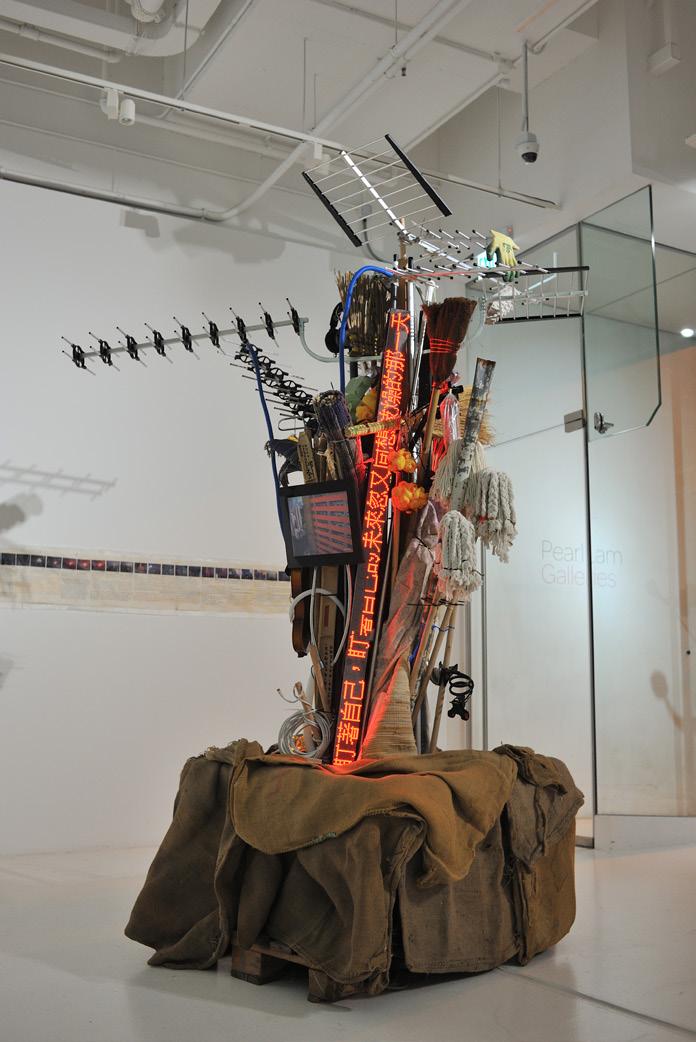
入其創作的新篇章。過去數十年,藝術家持續以科 技、物質及個人變化為出發點,回應城市生活中的 起伏跌宕。藝術家相信物件擁有超越人類能理解的 生命力。所以,藝術家發展出一套「有助記憶的歸 檔法」,一套極度私密的將歸檔、收集視為實驗性 歷史編篡法的實踐。重拾失去的物件與回憶是為了 肯定以往消失或改變的種種的存在。藝術家自考古 發掘場域的豐富潛質汲取靈感,被忽視的零散敘事 與影像層層疊疊地又開放式地呈現,讓展場中也可 以有個讓人聚集的焦點。藝術家盼望這些碎片能被 更多觀眾接觸,從而為將來提供更多閱讀可能性。
Candice Lin & P. Staff
Pearl Lam Gallery. / 黎肖嫻《物語生命樹, 2023 迭代版》,2023,混合媒介雕塑:日常物件、舊式電視天線、數碼部 件: 7 組錄像(循環播放於小屏幕上)、發聲用傳感器、 2 組 LED (文字循環播放)。尺寸可變。由藝術家及藝術門畫廊提供。

Hormonal Fog is a low-tech installation of tubing, ceramic objects, and hacked electronics, intertwined onto a wooden structure that doubles as a partition within the space. Both artists’ practices share an interdisciplinary concern of how technology and capitalist-driven consumption have changed the biological constitution of our bodies. In an experimental queer rereading of chemistry, botany, and DIY mechanics, Hormonal Fog aims to create a slow-forming cloud within the ecosphere of the exhibition. This intervention mimics the artificial aromas and chemicals inadvertently inhaled in the supposedly deodorized or sanitized airways of public spaces across a city. The discernment of what is culturally accepted as either healing or toxic is framed within a wider history of traditions that have been suppressed, renamed, or regulated by anxieties symptomatic of the colonial past, a legacy which continues into the contemporary age. With Hormonal Fog, the artists reveal our interdependence and vulnerability in relation to the porous boundaries among bodies, ecosystems, and institutions from a queer and trans perspective.

Linda Chiu-han Lai, Tree of Life, iteration 2023. Mixed media sculpture: everyday objects, TV antennas, digital components: mini screen and media player (7 sets), sensor system (for audio playing), 2 LED rods with running texts Dimensions variable. Courtesy of the artist and Pearl Lam Gallery. / 黎肖嫻《物語生命樹, 2023 迭代版》,2023,混合媒介雕塑:日常物件、舊式電視天線、數碼部 件: 7 組錄像(循環播放於小屏幕上)、發聲用傳感器、 2 組 LED (文字循環播放)。尺寸可變。由藝術家及藝術門畫廊提供。
黎肖嫻
《物語生命樹》是一座反紀念碑,對抗我們喜新厭 舊的消費慾。這棵圖騰柱一般的「樹」由回收物、 移動影像、詩詞以及有關藝術家生平的素材組 成——塑膠管、竹子、電子儀器、玩具、電視天 線、拖板(延長線)、錄像日記、素描,以及捲起 的布料,被繩子、金屬絲、塑料繩綑綁在一起。裝 置於 2017 年首度展出,是次的版本標誌着藝術家進
Candice Lin and P. Staff, Hormonal Fog, 2016–2023, hormonal Fog, hacked fog machine, herbal tincture, ceramics, acrylic panels, wood structure, miscellaneous household goods, lights, and timers. Dimensions variable. Installation view of ‘LESBIAN GULLS, DEAD ZONES, SWEAT AND T.’ at Human Resources, Los Angeles, 2017. Courtesy of the artists, Human Resources, François Ghebaly Gallery and Commonwealth and Council.
Photo: Ian
/ 林從欣與 P. Staff ,《荷爾蒙霧》,
2016–23 ,荷爾蒙霧、經改造的霧機、草藥製成的酊劑、陶瓷、壓克 力板、木造結構、各種家品、燈和計時器。尺寸可變。「 LESBIAN GULLS, DEAD ZONES, SWEAT AND T. 」,洛杉磯 Human Resources 展覽現場, 2017 年。由藝術家、 Human Resources 、 François Ghebaly 畫廊及 Commonwealth and Counci l提供。 攝影: Ian Byers-Gamber
10
Linda Chiu-han Lai, Tree of Life, iteration 2023. Mixed media sculpture: everyday objects, TV antennas, digital components: mini screen and media player (7 sets), sensor system (for audio playing), 2 LED rods with running texts Dimensions variable. Courtesy of the artist and
Byers-Gamber.
林從欣與 P. Staff
《荷爾蒙霧》是一件低科技裝置,由管子、陶瓷物 件、經過改造的電子產品,環繞在一個木架上組 成,並在展場中形成一道屏障。兩位藝術家的跨領 域實踐,都着重科技與資本主義驅動的消費行為, 是如何改變了我們的生理結構。作品以實驗性方 式,從酷兒角度重新解讀化學、植物學與 DIY (自 己動手做)的機制,嘗試在展覽的生態圈內緩緩生 成一片雲霧。作品以此模仿人們在城市的公共空間 中,往往不經意地吸入各類用以除臭或消毒的人工 香氛與化學物質。人們分辨藥物與毒物的常識,其 實是在長期受壓迫、抹去身份、或受過去殖民統治 造成的焦慮而自我設限,這樣更廣義的傳統歷史框 架下的反射,也成了一種延續到當下的後遺症。藝 術家透過這件作品,從酷兒、跨性別視角揭示在身 體、生態系統以及機構間的灰色地帶,我們的相互 依賴與無助。
to ask street vendors—tuk tuk drivers, food hawkers—to each participate in the making of these photographs by providing the source of light from their stall or vehicle. Through this web of ephemeral exchanges, an economy of chance becomes tangible and is reappropriated by the artist as a way to reconnect with people again.

Pratchaya Phinthong, “..”, 2018, pigmentary print, 32.5 × 47.5 × 2.5 cm (framed), edition 3 of 3 + 1 AP. Courtesy of the artist and gb agency, Paris / 巴德差耶.平通,《 “..” 》, 2018 ,數碼微噴,
裝裱尺寸: 32.5 × 47.5 × 2.5 cm ,版數:1/3 ,共 3 版,加藝術家自留
版。由藝術家及巴黎 gb agency 提供
Candice Lin and P. Staff, Hormonal Fog, 2016–2023, hormonal Fog, hacked fog machine, herbal tincture, ceramics, acrylic panels, wood structure, miscellaneous household goods, lights, and timers. Dimensions variable. Installation view of ‘STRESSED HERMS, SWEAT, & PERIOD GAS’ at ICA at NYU Shanghai, 2020. Courtesy of the artists, ICA at NYU Shanghai, François Ghebaly Gallery, and Commonwealth & Council. Photo: Hong Xiaole / 林從欣與 P. Staff
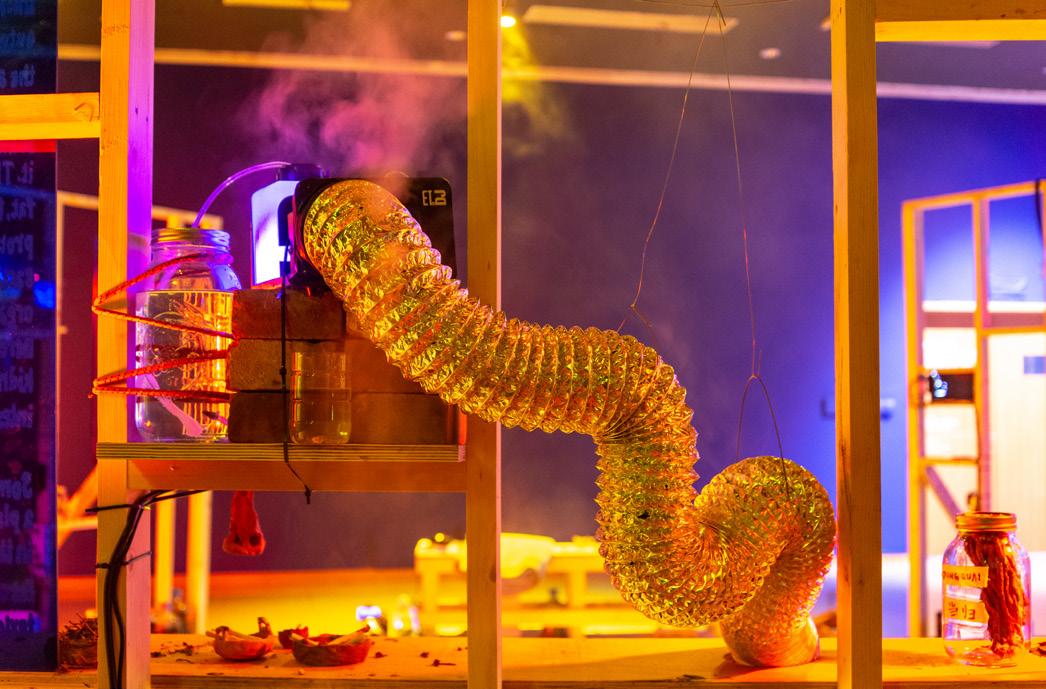
,《荷爾蒙霧》,
2016–23 ,荷爾蒙霧、經改造的 霧機、草藥製成的酊劑、陶瓷、壓克力板、木造結構、各種家品、 燈和計時器。尺寸可變。「兩性花、汗和經血雲」,上紐 ICA 展覽 現場, 2020 年。由藝術家、上紐 ICA 、 François Ghebaly 畫廊以及 Commonwealth and Council 畫廊提供。攝影: Hong Xiaole
Pratchaya Phinthong
Known for his conceptual strategies and interventions, Phinthong’s practice is often underscored by themes of displacement, exchange, and the transfer of artistic agency. The series of photographs appear to represent glittering stars as they sparkle in the night sky, varying in orientation from portrait to landscape, with each universe of dots held together by a mysterious force. Revealed in one of the photographs is a moment of self-reflexivity, which hints to the viewer the process behind making this series. The clues can be found along the margins of the photograph, where fragments of an urban scene reveal a soft backlit shot of a hand as it holds a board up to the audience. The reality is more prosaic and the perforations are revealed to be the holes of staple marks left by an anonymous community of lottery punters. Upon making the discovery of these patterns, the artist began
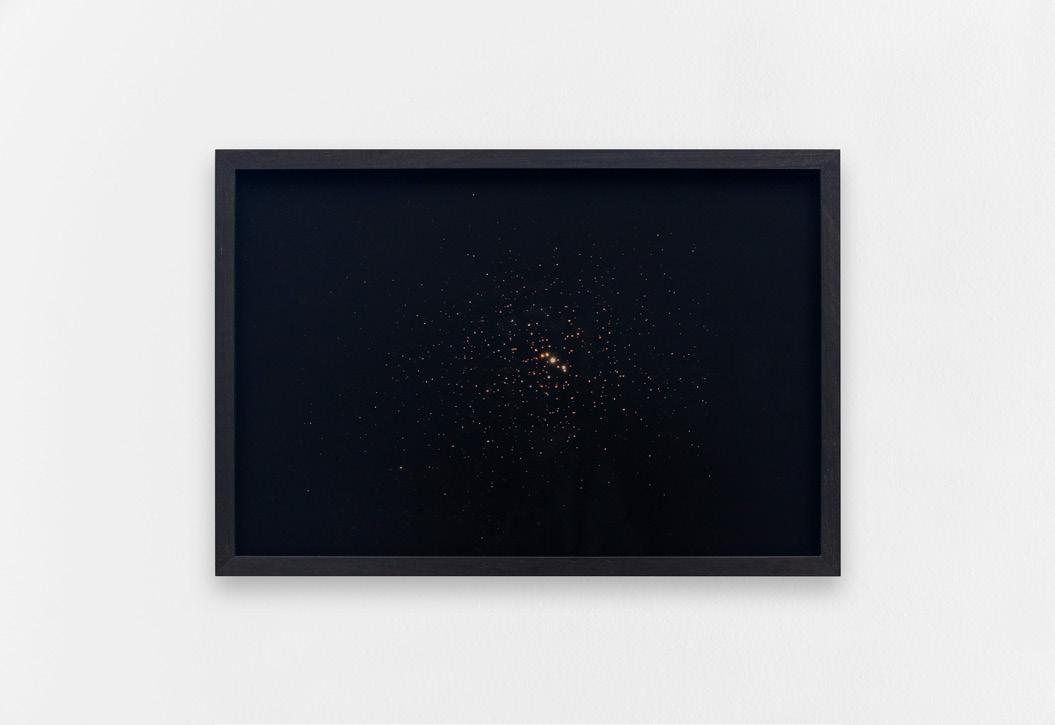
Pratchaya Phinthong, “.”, 2018, pigmentary print, 66.5 × 45 × 2.5 cm (framed), edition 3 of 3 + 1 AP. Courtesy of the artist and gb agency, Paris / 巴德差耶.平通,《 “.” 》, 2018 ,數碼微噴,
裝裱尺寸: 66.5 × 45 × 2.5 cm ,版數:1/3 ,共 3 版,加藝術家自留
版。由藝術家及巴黎 gb agency 提供
Pratchaya Phinthong
巴德差耶.平通以他的觀念策略和藝術介入而聞 名,他的實踐主題強調離散、交換、藝術自主性的 轉移。此系列的相片似乎捕捉了在夜空閃爍的點點 繁星,或直或橫,每一個獨特的星座都暗示着一個 可能由神秘的詩意力量凝聚成的宇宙。其中一幀相 片捕捉了一個微妙的動作,一個克制的、充滿自我 反思的瞬間,揭示了藝術家的創作過程。在照片的 邊緣我們可以找到一些線索:被切割成碎片的城市 場景中,可以看出前景有一隻柔和背光的手,正舉 着板子向觀眾展示。這些圖像在現實中其實平凡無
11
奇,不同的星座對應的是一群匿名的彩票投注者留 下的彩票穿孔標記。藝術家發現了這些毫無價值的 板子,並請街頭攤販用他們維生的燈光來照亮,有 時是篤篤車司機的車燈,有時是用小食檔口的燈 光。這一系列一閃而過的偶遇,為機會經濟賦予形 象,並為藝術家所用,與他人重建聯繫。
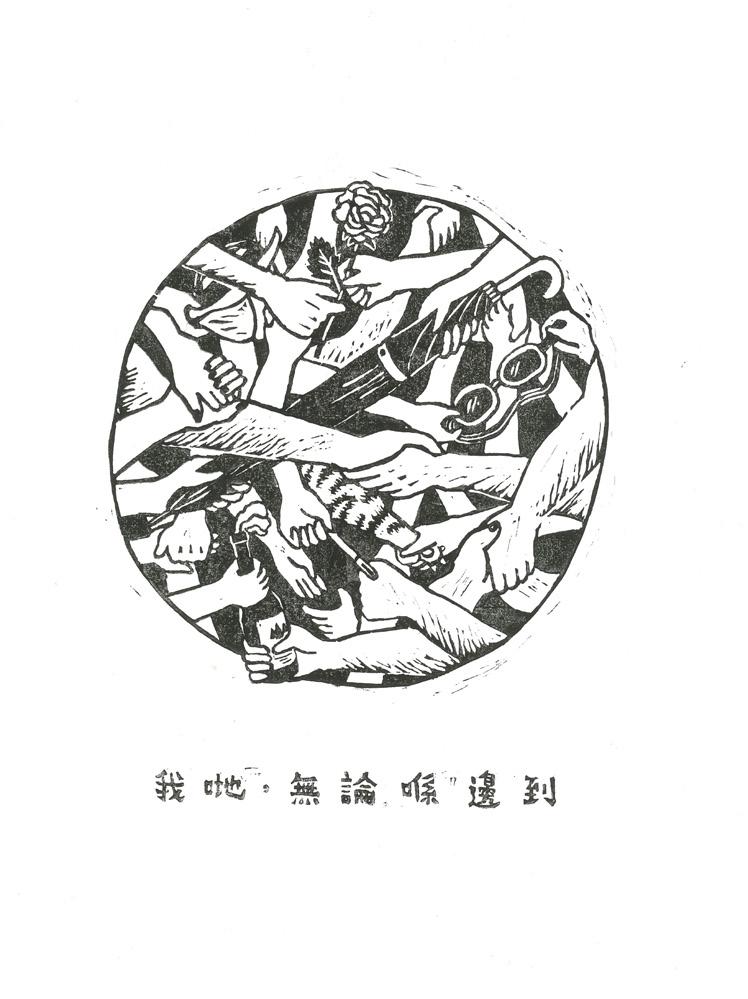
Printhow
Established in 2017, Printhow has engaged with various communities through print as a medium, frequently collaborating with migrant workers. No matter where WE are was created at the beginning of the 2019 protests, when members of the collective found themselves in a state of emotional flux. The work also coincided with the Migrant Pride March, and is thus infused with a spirit of mutual support. The hands in the print pass around different objects and communicate different faiths, representing individuals of various distinct identities—no matter where they are, they are driven by the perpetual desire to ‘be together’. Through a practice of DIT (do it together), Printhow instinctively responds to societal happenings in order to inspire more possibilities for both individual and collective creative practices. Everybody Chips in With Their Bit is inspired by an ukiyo-e woodblock print which depicts a scene of a collaborative printing process. Over the yearlong creative process, the members drew each other, delegated various tasks while simultaneously reflecting on the process of collaboration. The title of the work is a tribute to Mama Fred, a resident of Yau Ma Tei who members of Printhow considered to have embodied their ideals and worldview.
點印社
點印社於 2017 年成立,以版畫為媒介走入不同社群 當中,過往較多與在港移工團體合作。創作《我 地,無論喺邊度》時正值 2019 年街頭運動崛起,各 成員的心神隨着街頭事態發展忐忑動蕩。適逢當時 舉辦的移工同志嬌傲遊行,以作品寄意眾人能緊握 並支撐彼此。畫中的手傳遞着不同物件、信念,代 表不同身份、角色的他/她/ta們。如今無論身處牆 內或牆外,留散於本地或異鄉,「在一起」的寄望 依舊不變。成員以群體創作 D.I.T. ( do it together ) 本能性地回應生活、社會議題,在討論過程中啟發 更多個人與集體創作的想像與可能性。近作《一人 做啲》意念來自一幅浮世繪,原畫裡的人物分工合 作地製作版畫。橫跨了一年多的創作過程中成員互 畫對方,並分派畫中各人任務,共同想像在怎樣的 環境下製作版畫,和同時身邊有誰人一起共同創作 共同面對。作品名稱《一人做啲》向油麻地街坊傳 奇人物 Fred 媽致意,她的善心和行動力影響了很多 人,「一人做啲」(人人做一點)是其生前的口頭 禪,也是成員對於創作的理想模式,以至於對生以 為人的世界觀的一個期許。
James Richards
Qualities of life: Living in the radiant cold is an endoscopic probing, literal as well as metaphorical, of candid representations of bodies in relation to the environments they inhabit. The film gradually works its way through a montage of sampled images, textures, and patterns, which are interspersed with passages filmed either by the artist or his long-time collaborator Leslie Thornton. A mixture of X-ray pictures, online clips and images, other artists’ films, and scanned images of medical paraphernalia, convey a compulsive desire to probe at our own body and surroundings. The detritus of the artist’s own activities or entrails of found imagery are processed, cut, and juxtaposed into a nonlinear visual poem. An additional layer of meaning comes from the images culled from the archive of Horst Ademeit (1937–2010), as Richards found Ademeit’s obsessive personality mirroring his own experiences during COVID-19 lockdown. Leaving behind a considerable collection
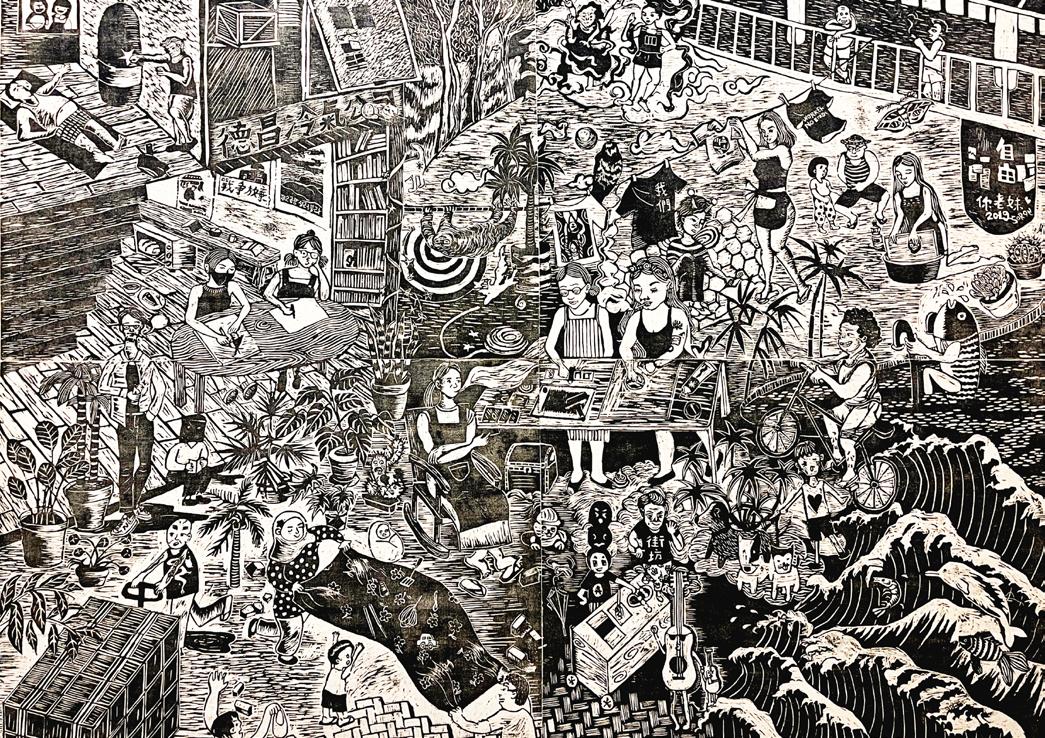
12
Printhow, Everybody Chips in With Their Bit, 2019–2020, relief printing: woodcut, 120 cm × 90 cm. Courtesy of the artist / 點印 社,《一人做啲》, 2019–2020 ,凸版:木版 , 120 cm × 90 cm 。
由藝術家提供
Printhow, No matter where WE are, 2019, relief printing: linocut, 20.5 × 20.5 cm. Courtesy of the artist / 點印社,《我地,無論喺邊 度》, 2019 ,凸版:膠版,2 0.5 × 20.5 cm 。由藝術家提供
of photographs and handwritten reflections, in his multi-decade documentation Ademeit chronicled his obscure fear of ‘cold rays’ that he believed was seeping through his home and affecting his body.
Wing Po So
James Richards, still from Qualities of Life: Living in the Radiant Cold, 2022, digital video, colour, sound 17’29”. Courtesy of the artist and Galerie Isabella Bortolozzi, Cabinet Gallery and Rodeo London/Piraeus, Commissioned By Fondazione between Art/ Film / James Richards ,《 Qualities of Life: Living in the Radiant Cold 》截屏, 2022 ,數碼有聲彩色錄像, 17 分 29 秒。 由藝術家、 Galerie Isabella Bortolozz i、 Cabinet Gallery 以及R odeo London/Piraeus 提供, 受 Fondazione between Art/ Film 委託創作
Newly commissioned for this exhibition, Inhale Exhale consists of air filters constructed into layered arches resembling the human trachea, through which the audience is invited to a purification experience. The aroma that permeates the installation comes from the powdered Indian gooseberry covering the air filters. The Indian gooseberry is an edible medicinal superfruit with antibacterial and detoxifying properties and which also promotes the secretion of saliva. The artist imagines the audience to be air molecules that are filtered and purified as they pass through the airwaylike installation, a process that also symbolises connection and transformation. As time goes by, the installation will evolve to incorporate elements including sound, light, and shadows. In her recent work Sea Ear Hi-hat, Wing Po So draws a connection between the spirals on abalone shells and the human inner ear. Seventeen abalone shells open and close gently at varying speeds on the exhibition floor, emitting sounds that recall uneven breathing patterns and, at times, morph into a melody of percussion instruments. Through this semimechanic formal presentation, the artist seeks to blur the boundaries between species and highlight various subtle associations among them.
James Richards, still from Qualities of Life: Living in the Radiant Cold, 2022, digital video, colour, sound 17’29”. Courtesy of the artist and Galerie Isabella Bortolozzi, Cabinet Gallery and Rodeo London/Piraeus, Commissioned By Fondazione between Art/ Film / James Richards ,《 Qualities of Life: Living in the Radiant Cold 》截屏, 2022 ,數碼有聲彩色錄像, 17 分 29 秒。由藝術家、 Galerie Isabella Bortolozz i、 Cabinet Gallery 以及R odeo London/Piraeus 提供, 受 Fondazione between Art/ Film 委託創作



此錄像作品是一次探索,既是字面上的也是隱含的透 過內視鏡,坦率地呈現身體及其棲居的環境。影片緩 緩地從一段包含樣本影像、紋理與圖案的蒙太奇展 開,間中夾雜藝術家和其長期合作者Leslie Thornton 拍攝的片段。X光片、網絡短片和圖片、其他藝術家的 影片與醫療器具的掃描圖混合在一起,激起我們探索 自己的身體與所處環境的強迫式慾望。藝術家本人的 行動產生的廢物與現成圖像的內容被加工、切割,並 置在一起,譜出非線性的視覺詩作。除此之外,藝術 家從德國素人Horst Ademeit(生於1937年,卒於 2010 年)檔案庫搜羅圖片,為影片增添了弦外之音; 藝術家認為Ademeit 的強迫症性格,和他自己在新冠 疫情封鎖期間的經歷不謀而合。Ademeit 留下了大量 的照片和手寫筆記,在數十年間持續地紀錄他對「冷 輻射」莫名的恐懼,深信此危機無所不在,更留意對 他身體的影響。
Wing Po So, Sea Ear Hi-hat, 2020, abalone shells, motors, brass, dimensions variable. Courtesy of the artist and X Museum. Photo courtesy of Blindspot Gallery / 蘇詠寶,《海洋耳朵開合 鈸》,2020,鮑魚殼、馬達、黃銅,尺寸可變。由藝術家及X美術館 提供。圖片由刺點畫廊提供。
蘇詠寶
是次展出的委約裝置作品《出入息》以空氣過濾網 摺疊製成,一層一層拱形設計建構出形似氣管的通 道,引導觀眾探入裝置當中去經歷淨化。觀眾於一 呼一吸之間慢慢地會察覺出空氣中淡淡的清新氣 味。氣味來自佈滿並覆蓋過濾網上,以中藥「餘甘 子」磨成的粉末。「餘甘子」又名「油甘子」,是 一種藥食兩用的超級水果,具抗菌排毒、生津解毒 等功效。藝術家把觀眾想像為空氣中無形的粒子, 穿過人體氣管時,各人身心的微塵濁氣都被潔淨過 濾、吸走,象徵着萬物之間互相牽引及轉化。裝置 作品會隨時間繼續流動,並融合聲音、光影等其他 元素。在近作《海洋耳朵開合鈸》中,蘇詠寶把鮑 魚殼的螺旋結構想像成人類內耳聽力的接收器。十 七件經過改造的鮑魚殼於展場地上以不同的速度輕
13
James Richards
微開合,時而撞擊地板,發出短促清脆的聲音。作 品發出的聲音猶如不規則的呼吸節奏,有時演變成 敲擊樂器的聲 響,又轉化成傳送器。藝術家透過此 半機械式的形態模糊物種之間的邊界,以探索人與 大自然之間千絲萬縷的連繫。
鈸》,2020,鮑魚殼、馬達、黃銅,尺寸可變。由藝術家及X美術館 提供。圖片由刺點畫廊提供。
Negative Entropy is a series of abstract jacquard fabric portraits. In many of Tajima’s works, there is a persistent inquiry into the agency of human subjectivity and the possibilities of the body amidst an increasingly technologically advanced built environment. The series title refers to the relationship between growth and decay to situate the process of the artist’s act of translation and transferral within a global flow of materials, activity, and energy. These portraits are created through field recordings that capture the ambient noise of locations from around the world ranging from server centers to factory floors, radio stations, and the construction site of condominiums. Each composition embodies a network of human mediators in relation to various industrial and information production sites. The process typically involves the conversion of a sound wave into a spectrogram of colors, which is embedded directly within the construction of the weave. The jacquard loom is considered a predecessor to mass automated technology and a prototype for computers, and the artist’s choice in using this technology hints at a longer historical relationship between control and collective human endeavor in connection to technological progress.
Mika Tajima, Negative Entropy (RSK Sanyo Broadcasting, Master Control Switchboard, Blue, Single), 2022, cotton, polyester, nylon, rayon, wool acoustic baffling felt, and white oak. 93.7 × 71.4 × 6 cm (framed). © Mika Tajima. Courtesy of the artist. Photo: Charles Benton / Mika Tajima ,《負值熵( RSK 山三洋送株式會社,總控制儀 表板,藍,單面)》, 2022 ,棉花、滌綸、尼龍、人造絲、羊毛隔音 毯、白橡木,裝裱尺寸: 93.7 × 71.4 × 6 cm 。 © Mika Tajima 。由藝術 家提供。攝影: Charles Benton


Mika Tajima, Negative Entropy (Toranomon Construction Site, Foundation Drilling, Black and White, Double), 2022, cotton, acrylic, nylon, polyester, wool acoustic baffling felt, and white oak, 142.6 × 110.2 × 6 cm (framed). © Mika Tajima. Courtesy of the artist. Photo: Charles Benton / Mika Tajima ,《負值熵 (虎之門工地,鑽 地基,黑白,雙面)》, 2022 ,棉花、壓克力、尼龍、滌綸、羊毛隔 音毯、白橡木,裝裱尺寸:142.6 × 110.2 × 6 cm 。 © Mika Tajima 。 由藝術家提供。攝影: Charles Benton
 Mika Tajima
Mika Tajima
《負值熵》是一系列緹花布織成的抽象肖像。藝術家 在作品中一直持續探問人類主觀的動力,以及處在日 新月異的科技和人工環境中的身體的各種可能性。系 列作品的命名意指成長與衰退間的關係,並用以定位 藝術家在物質、活動與能源的全球流動中所進行的轉 譯和轉移。藝術家在世界各地各種場所現場收音,包 括伺服器數據中心、工廠車間、廣播電台、公寓建設
14
Mika Tajima
Wing Po So, Sea Ear Hi-hat, 2020, abalone shells, motors, brass, dimensions variable. Courtesy of the artist and X Museum. Photo courtesy of Blindspot Gallery / 蘇詠寶,《海洋耳朵開合
工地等等,來創作這些肖像。每件作品的構圖都體現 了擔任中介的人類所組成的網路,與不同工業和資訊 生產場地的關係。藝術家的創作過程通常涉及將聲波 轉換成數碼色彩圖譜,而數碼訊息被轉化並直接嵌入 緹花圖案的編織中。緹花紡織機被認為是大規模自動 化科技的前身與電腦的原型;藝術家透過選用緹花紡 織機,暗示在更長遠的歷史上,人類為科技進步共同 所做的努力與控制之間的關係。
Tang Kwok Hin
In the newly commissioned Shoulder to Shoulder, Tang Kwok Hin makes use of accumulated remnants of daily life and past works, compressing them within layers of wood panels. These neglected, miscellaneous fragments and discards traverse quotidian spaces and boundaries to become exiled surpluses from the past. Useful or useless, the array of objects constitutes spiritual byproducts of the creative process, trapped between social systems in a broken, haphazard existence that’s at once negligible and fraught with struggles. The installation challenges the formal conventions of display to allow for an aesthetic language unto the discarded materials themselves. Over the course of the exhibition, the structure of the installation will gradually open up into different configurations in a constant process of osmosis.
‘The city is populated by archetypes of outlines. Shops and streets; avenues and roads; red, yellow, and green; train cars, platforms, and ticket readers, and turnstiles.
People cross paths, brushing shoulders, as though damp matches trying to get lit.
Cold yet dry.
The demarcation between the real and the unreal fades.
The mannequins in shop windows tire occasionally, lying down on a bed of broken glass that traverses two worlds. How does one cross over? Or take a detour?
People have forgotten how to pass through when the traffic lights are off.
A little distracted.
The gleaming metropolis reflects off our skin and wedding dress.
Honesty, bashfulness, eros, scars—all wrapped up. With time, the information and imagination overload from any one person, event, or object can implode.
The discharge, wounded, struggle forward to form a river of blood flowing in all directions.
Fragments of faith once held now left at home— how do they connect from then to now?
The baggage deep in storage similarly stands shoulder to shoulder.
Fresh water flows from wounds.
Try to scoop it up in your palms.
Can you catch it between your fingers? A scoop, after another absentminded scoop.’
—Tang Kwok Hin
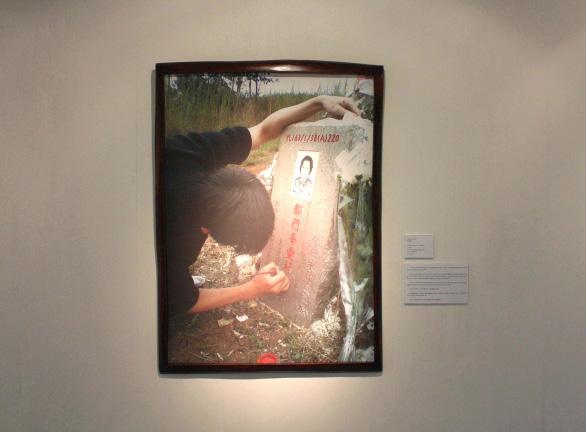
Tang Kwok Hin, Shoulder to Shoulder, 2023, remnants of previous artwork, digital printing on photo paper, mixed media, sound, plywood, wooden, batten. Dimensions variable. Commissioned by Para Site for this exhibition / 鄧國騫,《肩擦肩》, 2023 ,舊作殘 件、數碼相紙打印、混合媒介、聲音、木板、木條。尺寸可變。受 Para Site 藝術空間委託為本次展覽製作
鄧國騫
藝術家在是次委約裝置作品《肩擦肩》中以日常生 活及過往創作當中存積多時的殘件壓縮組合,並收 藏於一層層的木板中。這些不被察見、重覆交錯的 碎片與殘破廢料於日常中橫跨不同空間、界線;同 時,過往的創作遺物被放逐為剩餘物資。這些有用 無用的東西都是創作時的精神產物,綑綁在體制夾 縫間破碎地,不經意地,若穩若現地,掙扎地存 在。裝置作品將挑戰展覽的固有展示與觀賞形式, 讓殘件和遺物呈現出不同的美學。作品結構將會逐 步打開並以不同的組合呈現持續進行、互相滲透的 變化。
「城市四處是邊線明確的典範。
店與街;路與道;紅黃綠;車卡月台入閘機。
人來人往,肩擦肩像劃濕掉的火柴。
冷漠卻烘乾。
實景或虛空勾劃的邊線蓄勢由實轉虛。
櫥窗的人偶累了,倒臥橫跨兩個空間的玻璃碎床。
目下是跨越?是繞路?
人們忘記交通燈沒亮起時該如何通過。
稍稍出神。
光潔亮麗的大都會物料映照自我的皮囊與嫁衣裳。 赤誠、羞澀、情色、傷痕,被裝束包裹。
每單一人事物隨歲月及日常載具傾倒大量訊息和想 像能撐破肚皮。
溢出的像破敗的殘件負傷前行交會成無形的血河四 通八達。
擱在房子原有的信念碎片如何接軌當下?
肩擦肩同樣是儲物房深處互相依傍的包袱。
新的完整,是傷痕累累的流水。
伸手探知在掌心內勉強一瓢。
指間是否趕及留下?一瓢,不經意又取一瓢。」
——鄧國騫
15
Truong Cong Tung
Truong grew up in Dak Lak among various indigenous ethnic minorities in the Central Highlands of Vietnam, a region with a long history of plantations. Now living in Ho Chi Minh City, he has developed a cyclical practice involving ceramics, lacquer, electronic sound, bamboo, and gourd that explores the cultural, agricultural, and economic significance of the Dak Lak region as it undergoes radical changes due to the intensive exploitation and rapid deforestation. One of the indigenous communities that Truong has regularly collaborated with are the Jarai people, whose customs and spiritual beliefs have deeply influenced the artist. In Jarai philosophy, humans go through many cycles of existence, where the final stage is to transform into dew and evaporate into the environment—a state of non-being that signals the beginning of a new existence. The state of absence—voices from outside is an ongoing installation series that has constantly evolved across different iterations and locations as a collaboration between living beings, organic objects, and human-made elements. Truong regards his position as an intermediary to a process of transfiguration, creating a generative ecology for different species and non-human actors to coexist. Within this topology, the role of plants, insects, earth, water, ash, and air are considered as active participants to the metamorphosis of this installation.
元素的協作。張氏視自己為轉變過程中的中介,開 創出一個不同物種與非人類參與者能夠共存的空 間。在此語境下,植物、昆蟲、土壤、水、灰燼及 空氣都是積極參與裝置的蛻變過程。
Truong Cong Tung, The state of absence—voices from outside, 2020–present, gourds, water, soil, seeds, machinery, time, and temperature. Dimensions variable. Courtesy of the artist / 張公松, 《The state of absence—voices from outside》,2020至今,葫蘆、 水、泥土、種子、機械、時間及氣溫。尺寸可變。由藝術家提供
張公松
張公松於越南中部高地、少數民族聚居的多樂省成 長,該地區因其肥沃的土地有着長久的殖民歷史。 現居胡志明市的張氏發展出了一套持續的創作流 程,運用瓷器、塗漆、電子聲音、竹子、葫蘆等媒 介,探索多樂地區在無情榨取及森林砍伐下遭受的 文化、農業及經濟劇變。該地區內與張氏經常合作 的其中一個少數民族為嘉萊族——他們的習俗與精 神信仰對藝術家有着深遠影響。在嘉萊族哲學中, 人的存在經過多番循環,最後變成露水在環境中蒸 發——一種預示新生的非存在狀態。作品《 The state of absence—voices from outside 》為持續 根據場域變化的裝置系列,是生物、有機物與人造
Truong Cong Tung, The state of absence—voices from outside, 2020–present, gourds, water, soil, seeds, machinery, time, and temperature. Dimensions variable. Courtesy of the artist / 張公松, 《The state of absence—voices from outside》,2020至今,葫蘆、 水、泥土、種子、機械、時間及氣溫。尺寸可變。由藝術家提供

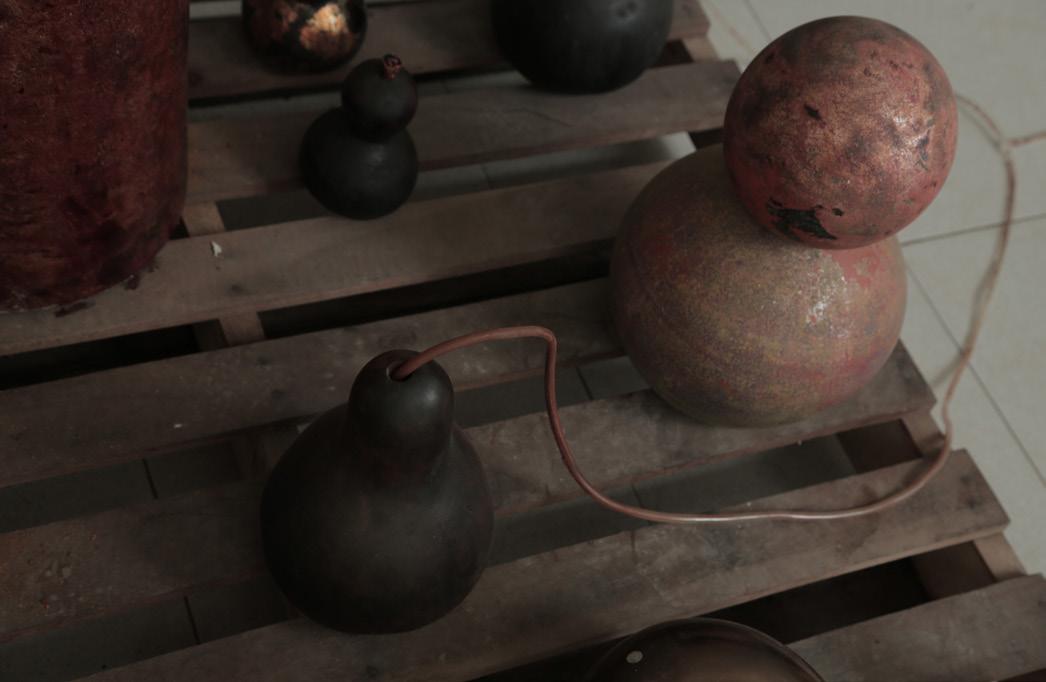
16
About the Artists 藝術家簡介
Christine Sun Kim
In her work, artist Christine Sun Kim, whose first language is American Sign Language (ASL), approaches the concept of sound via deconstructive exercises, experiments, and observations through drawing, painting, and performance. Over the course of developing her own visual language, Kim explores and employs elements from various information systems. By combining aspects of graphic and musical notation, body language, and ASL, she uses these systems as a means to expand what each is able to communicate and to invent a new grammar and structure for her compositions. Kim received her MFA in Music/Sound from Bard College in 2013. She has exhibited and performed internationally, including at Queens Museum, New York (2022); the Whitney Museum, New York (2019); Art Institute of Chicago (2018); San Francisco Museum of Modern Art (2017); De Appel Arts Center, Amsterdam (2017); Berlin Biennale (2016); Shanghai Biennale (2016); Sound Live Tokyo (2015 and 2013); MoMA PS1, New York (2015) and the Museum of Modern Art, New York (2013). Kim was awarded an MIT Media Lab Fellowship and a TED Senior Fellowship and has presented at numerous conferences and symposia.
聲音藝術家 Christine Sun Kim 的母語是美國手 語,她的藝術實踐形式包括草圖、繪畫和行為表 演等,並通過在其中進行解構練習、實驗和觀察 來處理聲音的概念。在發展個人視覺語言的過程
中, Kim 探索並運用了來自多種信息系統的元素。
她的作品結合了繪畫圖形、音樂記譜法、肢體語言 和美國手語等,並運用這些系統去擴展每個獨立系 統的交流可能性,為自己的藝術創作發明一種新的 語法和結構。 Christine Sun Kim 2013 年在巴德學 院獲得聲音藝術碩士學位。她在國際上多個機構展 覽和表演,其中包括:紐約皇后區博物館,( 2022 年);紐約惠特尼雙年展( 2019 年);芝加哥藝術
學院( 2018 年);三藩市現代藝術博物館(2017 年);阿姆斯特丹蘋果藝術中心( 2017 年);柏林
雙年展( 2016 年);上海雙年展( 2016 年);東 京 Sound Live Tokyo 藝術節( 2015 及 2013 年); 紐約 MoMA PS1 ( 2015 年);紐約現代藝術博物館 ( 2013 年)。 Kim 獲 TED 獎助金和麻省理工學院 媒體實驗室獎助金肯定,經常於研討會發表作品。
Linda Chiu-han Lai 黎肖嫻
Interdisciplinary artist Linda Chiu-han Lai works at the intersection of experimental moving images, the history of everyday life, and media archaeology. She is interested in the duality of humans and machines in everyday activities and urban life, historiography, and the visual language and auto-ethnography through cinema. She has shown her video work internationally,
including at EXiS Experimental Film & Video Festival, Seoul (2017) and EXiM Macau Experimental Video Festival (2016). Her works are in the collections of Power Station of Art, Shanghai; and M+, Hong Kong. She is the founder of the Writing Machine Collective. In 2015, she started her experiments in participatory art as Floating Projects, with recently published works including Our Manifestos II: Videography, Documentary Impulses (2021) and five video zine issues titled ‘D-Normal/V-Essay’ (2020–present), among others. She was the Hong Kong Arts Development Council Artist of the Year in Media Art 2017. She is an associate professor at the School of Creative Media at the City University of Hong Kong.
香港跨領域藝術家黎肖嫻的作品處於實驗性影像、 日常歷史以及媒體考古學的交匯處。她對人與機 械之間的相互作用感興趣,在日常活動與城市生活 中,透過電影等流動影像找出歷史敘述、視覺語 彙、自主民俗學相關連的痕跡。她的錄像作品曾 於首爾 EXiS 實驗電影與錄像藝術節( 2017 年)及 EXiM 澳門實驗錄像藝術節( 2016 年)等國際場域 展出,也是上海當代藝術博物館以及香港 M+ 博物 館館藏。她是文字機器創作集的創辦人。 2015 年, 她開始於「據點。句點」進行參與藝術的實驗,並 出版了《我們的錄像宣言 2 :記述的衝動》( 2021 年)以及《平地數碼》影像雜誌( 2020 年至今)。 她是 2017 年香港藝術發展局年度媒體藝術家,現為 香港城市大學創意媒體學院副教授。
Candice Lin 林從欣 & P. Staff
Candice Lin and P. Staff live and work in Los Angeles and have been collaborating since 2010. The artists’s collaborative practice focuses on the queer potential of herbal practices, hacked technologies, and crossspecies interactions. They have presented their work at Institute of Contemporary Arts, NYU Shanghai (2020); Institute of Contemporary Arts, London (2019); Walker Art Center, Minneapolis (2019).Henry Art Gallery, University of Washington, Seattle (2018); and New Museum, New York (2017).
林從欣與 P.Staff 自 2010 年起於洛杉磯展開合作。
他們的創作主題包括草藥的酷兒潛質、技術 黑客以及物種間的互動。他們曾在各地機 構展出,包括以及上海紐約大學當代藝術 中心( 2020 年)、倫敦當代藝術學院 ( 2019 年)、明尼阿波利斯沃克藝術中心( 2019 ) 、西雅圖華盛頓大學亨利美術館( 2018 年) 、紐約新當代藝術博物館( 2017 年)。
Pratchaya Phinthong 巴德差耶.平通
Pratchaya Phinthong considers himself an alchemist of economic value and social functions. In his work, financial fluctuations, reactionary media, and the world labour market are translated
17
Printhow, Everybody Chips in With Their Bit , 2019–2020, relief printing: woodcut, 120 cm × 90 cm. Courtesy of the artist / 點印社,
《一人做啲》, 2019–2020 ,凸版:木版 , 120 cm × 90 cm 。由藝術家提供

18
into matter as it cycles through the physical forms of solid, liquid and gas. The artist’s conceptual intervention operates according to a logic opposite to that of profit and deals in cultural and value systems, while trafficking in everyday meanings, hopes, and troubles. His recent exhibitions have been presented at the Istanbul Biennial (2022); Hayy Jameel, Jeddah (2021); Silpakorn University Art Center, Bangkok (2021); Centre Pompidou, Paris (2020); Tai Kwun Contemporary, Hong Kong (2020); Bangkok Art & Culture Centre (2013); and Documenta 13, Kassel (2012).
巴德差耶.平通視自己為一名經濟與社會的煉金術 士。其作品將經濟起伏、傳媒杞憂以及全球勞工市 場實體化,在固、液、氣態之間循環轉化。藝術家 的觀念性作品摒棄商業利潤邏輯、交易文化與價值 體系,並在其中偷渡日常的意涵、期望與煩憂。他 近期在各地參與展覽,包括伊斯坦堡雙年展( 2022 年);吉達賈米爾 Hayy 創意中心( 2021 年);曼 谷泰國藝術藝術中心大學藝術中心( 2021 年); 巴黎龐畢度中心( 2020 年);曼谷藝術文化中心 ( 2013 年);第十三屆卡塞爾文獻展( 2012 年) 等。
Printhow 點印社
Printhow is inspired by the block-print collective A3BC in Japan, the Print and Carve Department in Taiwan, and other collective print-making practices from South America. It started when several printmakers in Hong Kong, some of them novices, got together and started making prints. They hope to engage with the public and friends from different communities through the DIY (do it yourself) and DIT (do it together) spirits of this medium in the pursuit of a better life, at the same time hoping to create more ‘silly’ prints in the future, among other possibilities. They have organised and participated in exhibitions at many alternative spaces in the region, including Black Window, Hong Kong (2022); TheCube Project Space, Taipei (2022); and the Back Room, Kula Lumpur (2020). They have participated in events including Hong Kong Queer Literary and Cultural Festival' (2019); Migrants Pride Hong Kong (2019, 2018, and 2017); and One Billion Rising Revolution (2018 and 2017).
點印社受日本 A3BC 、台灣印刻部,及南美的版畫 群體所啟發,聚合了幾個志同道合的版畫友及新 手,一起製作版畫,希望藉由這個具 D.I.Y. (自己 動手做)精神的媒介,走入不同的社群當中,然後 在追求美好生活的路上,逐漸發展成跟大家一起創 作( D.I.T. , do it together ),希望在未來眾多可能 性中也一起多做些「無聊」的印刷。曾策劃與參與 在東亞及東南亞地區的獨立空間展覽,包括在香港 黑窗里( 2022 年);台北立方計劃空間( 2022 年)、 及吉隆坡 The Back Room ( 202 0年)。曾參與活動 包括香港同讀文化節 ( 2019 年)、香港移工嬌傲遊行 ( 2017 、 2018 、 2019 年)、及「億萬人起動」 ( 2017 及 2018 年)。
James Richards
Known for his provocative and visually seductive videos and films that splice together intimate home movies, archival footage, television signals, and musical soundtracks, James Richards addresses in his works the relentless flow of imagery that has come to define the 21st century and where personal politics gel with digital materiality. Richards has presented numerous exhibitions and projects informed through archival research and exchanges with other artists. He has exhibited his works at Kunsthall Malmö (2019); Institute of Contemporary Arts, London (2016 and 2008); in the 14th Istanbul Biennial (2015); Whitechapel Gallery, London (2015); the 55th Venice Biennale (2013); Performa 11, New York (2011); and Artists Space, New York (2008). In 2017, Richards represented Wales at the 57th Venice Biennale, and was shortlisted for the 2014 Turner Prize.
James Richards 以其充滿挑釁與誘惑的移動影像
作品著稱,並運用居家錄影、歷史片段、電視信號 及豐富的配樂,於廿一世紀的影像洪流之中拼貼出 一個個人政治與數碼物質性得以邂逅的空間。他曾 舉辦多次圍繞文獻資料搜集,以及與其他藝術家合 作的展覽。他的作品曾於馬模美術館( 2019 年)、 倫敦當代藝術中心( 2016 及 2008 年)、第十四屆 伊斯坦布爾雙年展( 2015 年)、倫敦白教堂美術 館( 2015 年)、第五十五屆威尼斯雙年展(2013 年)、紐約 Performa 11( 2011 年),以及紐約 Artists Space ( 2008 年)展出。他曾於2017年代 表威爾士參與第五十七屆威尼斯雙年展,並於 2014 年獲提名透納獎。
Wing Po So 蘇詠寶
Wing Po So was born into a family of Chinese medicine doctors and grew up surrounded by medicinal ingredients, and therefore chooses to transform these elements into raw materials for playthings and eventually artworks. When natural materials become medicinal ingredients, they are often dehydrated, cut into pieces, and burnt. So's works deal with this process of alienation in nature and the living environment. Incorporating pharmacological herbs and daily objects into large-scale installations and sculptures, So weaves Chinese medical and philosophical thinking into wonders that reconstruct the correlation of matter and being. So has exhibited her works at the Kathmandu Triennale (2022); Para Site, Hong Kong (2020); and Tai Kwun Contemporary, Hong Kong (2018). In 2018 she published an artist book titled From Space to Space .
蘇詠寶成長於傳統中醫學世家, 自幼接觸和觀察各 種藥材。擅以其熟悉的中醫藥材及日常物創作大型 裝置和雕塑,將草藥從兒時的玩物,轉化成現在她 藝術創作的主要媒介。當自然物成為藥用材料,它 們往往被抽乾水份、斬斷切片、燒焦、 蟲蛀——蘇 氏的作品處理這種對自然和環境的陌生感和疏離
19
Wing Po So, Sea Ear Hi-hat , 2020, abalone shells, motors, brass, dimensions variable. Courtesy of the artist and X Museum. Photo courtesy of Blindspot Gallery / 蘇詠寶,《海洋
耳朵開合鈸》, 2020 ,鮑魚殼、馬達、黃銅, 尺寸可變。由藝術家及X美術館提供。圖片由刺 點畫廊提供。
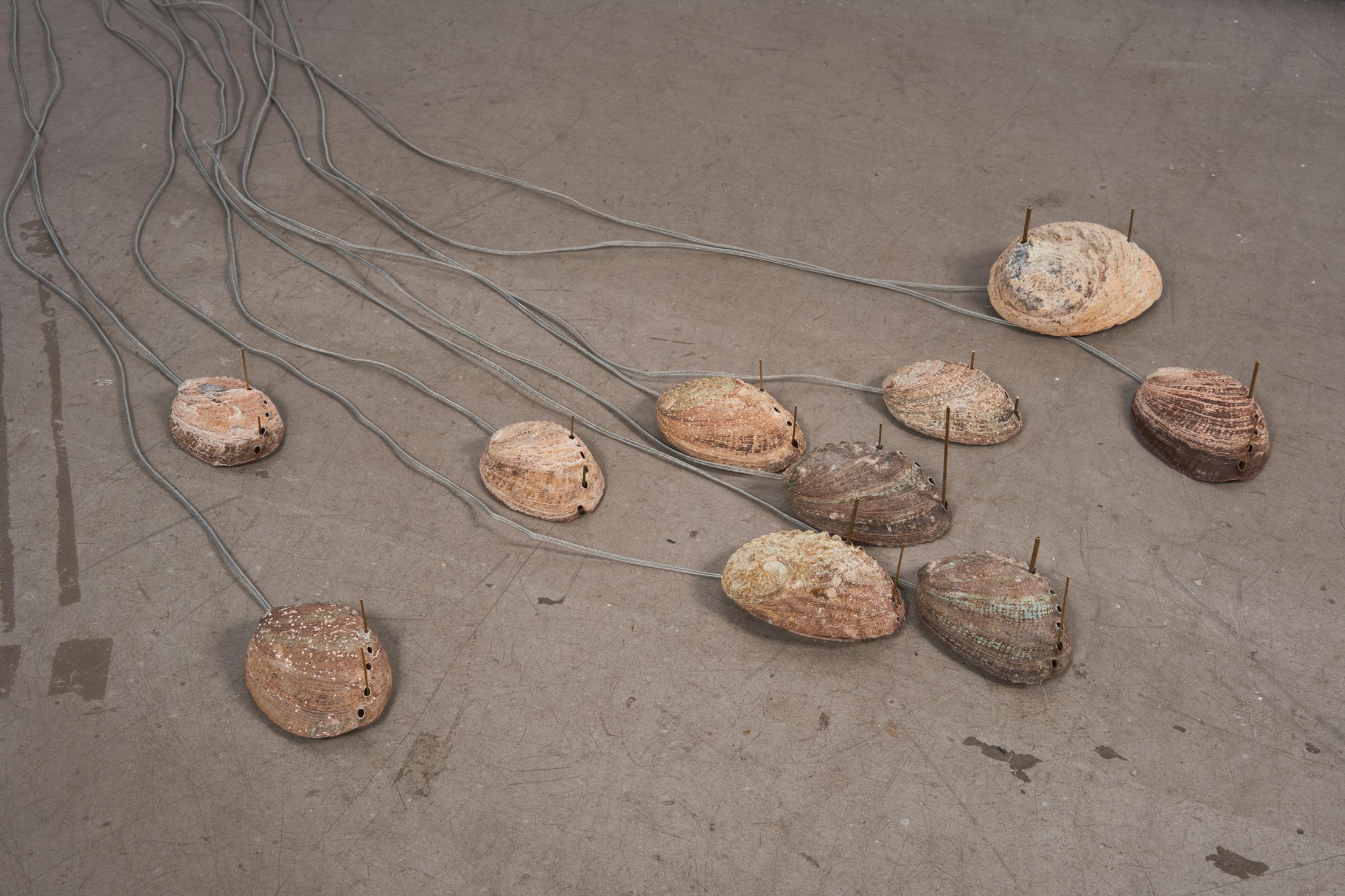
20
感。中醫學源於對自然的觀察、探索以及想像,她 的藝術創作便是建立於此精神上,探討生命結構、 生存體系的物質性和關係性。她的作品曾在加德 滿都三年展( 2022 年)、香港 Para Site 藝術空間 ( 2020 年)、香港大館當代美術館( 2018 年)等 機構展出。 2018 年,蘇詠寶出版了藝術家書籍《微 物萬狀》。
Mika Tajima
Mika Tajima’s practice materialises techniques developed to shape the physicality, productivity, and desires of the human body. Her sculptures, paintings, videos, and installations focus on the embodied experience of ortho-architectonic control and computational life. From architectural systems to ergonomic design to psychographic data, Tajima’s works operate in the space between the immaterial and the tangible to create heightened encounters that target the senses and emotions of the viewer, underlining the dynamics of control and agency. Selected exhibitions include those at Centre Pompidou, Paris (2022); San Francisco Museum of Modern Art (2022 and 2012); Hawaii Triennial, Honolulu (2022); Whitney Museum of American Art, New York (2018); the 11th Gwangju Biennale (2016); SculptureCenter, New York (2016 and 2010); and Mori Art Museum, Tokyo (2013). Her work is in the collections of Los Angeles County Museum of Art; Hammer Museum, Los Angeles; San Francisco Museum of Modern Art; Dallas Museum of Art; Buffalo AKG Art Museum; and Hirshhorn Museum and Sculpture Garden, Washington, D.C.
Mika Tajima 的創作把塑造人肉身、生產力及慾望 的技巧具象化。其雕塑、繪畫、錄像及裝置聚焦在 方正知識體系控制下,電腦化生活的人身經歷。從 建築系統、人體工學到心理數據, Tajima 的作品運 行於無形與有形之間的地帶,提升觀者接觸作品時 的感官與情緒,並藉此強調操控力與能動力之間的 張弛。她曾在巴黎龐畢度中心( 2022 年)、三藩市 現代藝術博物館( 2022 年)、檀香山夏威夷三年展 ( 2022 年)、紐約惠特尼美國藝術博物館( 2018 年)、第十一屆光州雙年展( 2016 年)、紐約雕 塑中心( 2016 及 2010 年)、東京森美術館( 2013 年)等機構展出作品。其作品藏於洛杉磯郡藝術 博物館、洛杉磯漢默美術館、三藩市現代藝術博物 館、達拉斯藝術博物館、水牛城 AKG 美術館,以及 華盛頓特區赫尚博物館和雕塑園。
Tang Kwok Hin 鄧國騫
Tang Kwok Hin is a mixed media artist. Tang’s artistic practice originates from his inquiries into his heritage as an indigenous inhabitant, and is developed through and closely related to his own life experiences. He is always immersed in the complex, contradictory, and struggling present. Through observing his surroundings, he reflects on himself and those around him. Weaving through reality and imagination, and anyone and anything between
the old and the new, he applies objects, installations, moving images, performances, and collages as a comprehensive approach to reveal emotions, thoughts, and essences deep down at particular moments amongst chaos. His subject matters deal with growth, inheritance, locality, freedom, urbanisation, consumption, nature, politics, norms, and existence. He was awarded the first prize at the Hong Kong Contemporary Art Biennial in 2009 and was also a grantee of Asian Cultural Council in 2013. He received his MFA from the Chinese University of Hong Kong in 2008 and BA in fine arts in 2006.
鄧國騫是一位混合媒介藝術家, 2008 及 06 年分別取 得香港中文大學藝術系藝術碩士及文學士。鄧氏的 創作始於對其原居民背景及生活點滴的追問,繼而 發展出緊扣其生命進程與經歷的探索。他總沉浸於 複雜、矛盾、掙扎的當下裡,從身邊及耳聞目睹中 反思自身與他人、現實與想像、過去與現在等人事 物,繼而運用物件、裝置、移動影像、行為、拼貼 等綜合手法在混沌的情境裡呈現某時某刻深埋的情 緒、意念及本質性。其作品主題觸及成長、承傳、 本土、自由、都市、消費、自然、政治、規範、存 在等。 2009 年獲香港當代藝術雙年獎優秀獎,亦為 2013 年亞洲文化協會獎助金得主。
Truong Cong Tung 張公松
Truong Cong Tung grew up in Dak Lak among various ethnic minorities in the Central Highlands of Vietnam. With research interests in science, cosmology, philosophy, and the environment, Truong Cong Tung works with a range of media, including video, installation, painting, and found objects, which reflect personal contemplations on the cultural and geopolitical shifts of modernization, as embodied in the morphing ecology, belief, and mythology of a land. He is a member of Art Labor (founded in 2012), a collective working between visual art and social and life sciences to produce alternative non-formal knowledge via artistic and cultural activities in various public contexts and locales. Truong has exhibited extensively internationally as a solo artist and as part of Art Labor Collective. Select recent exhibitions include MAIIAM Contemporary, Chiang Mai (2020); Kunsthall Trondheim (2019); Sàn Art, Ho Chi Minh City (2019); Bangkok Biennale (2018); Para Site, Hong Kong (2018 and 2017); Museum of Modern Art, Warsaw (2018); Dhaka Art Summit (2018); The Secretariat & Myanm/art Gallery, Yangon (2018); Kadist, San Francisco (2016); Taipei Biennial (2016); and Seoul Mediacity Biennale (2014). He graduated from the Ho Chi Minh City Fine Arts University in 2010.
張公松成長於越南中部高地、少數民族聚居的多樂 省, 2010 年畢業於胡志明市美術大學。他的研究範 疇涵蓋科學、宇宙學、哲學及環境,創作媒介包括 錄像、裝置、繪畫以及尋獲物件。從中,他反思現 代化進程中,化身為地域生態、信仰及神話的文化 與地緣政治變化。他是藝術團體 Art Labor 成員——
21
該團體創立於 2012 年,於視覺藝術、社會及生命 科學之間進行創作,透過藝文活動在不同公共領域 生產出另類的非形式化知識。他曾以個人及團體 身分於多地參與展覽,包括清邁 MAIIAM 當代藝術 博物館( 2020 年)、特倫汗美術館( 2019 年)、 胡志明市 Sàn Art ( 2019 年)、曼谷雙年展( 2018 年)、香港 Para Site 藝術空間( 2018 及 2017 年) 、華沙現代藝術博物館( 2018 年)、達卡藝術峰 會( 2018 年)、仰光秘書處及 Myanm/art 畫廊 ( 2018 年)、三藩市 Kadist 藝術基金會( 2016 年)、台北雙年展( 2016 年)、首爾媒體城市雙年 展( 2014 年)。
22
Truong Cong Tung, The state of absence— voices from outside , 2020–present, gourds, water, soil, seeds, machinery, time, and temperature. Dimensions variable. Courtesy of the artist / 張公松,《 The state of absence— voices from outside 》, 2020 至今,葫蘆、水、

23
泥土、種子、機械、時間及氣溫。尺寸可變。
由藝術家提供
Para Site is Hong Kong’s leading contemporary art centre and one of the oldest and most active independent art institutions in Asia. It produces exhibitions, publications, discursive, and educational projects aimed at forging a critical understanding of local and international phenomena in art and society.

Para Site 藝術空間為香港知 名當代藝術中心,亦是亞洲歷 史最悠久、最活躍的獨立藝術 機構之一。成立宗旨在透過 展覽、出版刊物及教育項目等 活動,促進在地與國際間的 對話,希冀打造一個對當代藝
術、社會現象提出批判性論述 及理解的平台。
signals … 瞬息
瞬息 signals
18.03–29.09.2023

signals…storms and patterns
瞬息 風中序 18.03–28.05.2023
Curators 策展人
Billy Tang 曾明俊
Celia Ho 何思穎
Project Coordinators
項目助理
Harold Chan 陳碩智
Jackson Kwong 鄺俊軒
Helen Leung 梁晞藍
Spatial Design 空間設計
Joel Austin
Graphic Design 平面設計
Geoff Han 韓穎加
Immanuel Yang
Translation 翻譯
Jason Chen 陳子岳
Vivian Qin 覃小詩
Catalogue Print and Production 場刊印刷製作
Allion Printing Co., Ltd 雅聯
印刷有限公司
Para Site 藝術空間獲香港特別 行政區政府「藝術發展配對資 助計劃」的資助。香港特別行 政區政府僅為該展覽提供撥款 資助,並無參與其中。在刊物/活 動內(或 Para Site 成員)表達 的任何意見、研究成果、結論 或建議,純屬該展覽的推行機 構的觀點,並不代表香港特別 行政區政府的觀點。
The exhibition is supported by M Art Foundation.
展覽由 M Art Foundation 贊助 Logistics Partner 物流贊助
PARA SITE TEAM PARA SITE 團隊
Billy Tang 曾明俊 Executive Director and Curator
執行總監兼策展人
Kelly Ma 馬元中 Deputy Director 副總監
Celia Ho 何思穎 Curator 策展人
Cusson Cheng 鄭家醇 Assistant Curator
助理策展人
Kobe Ko 高穎琳 Assistant Curator
助理策展人
Marlene Lieu 呂瑪琳 Exhibition Manager
展覽經理
GLOBAL COUNCIL 環球協會
Shane Akeroyd
Mimi Brown & Alp Ercil
Jehan Chu
Mimi Chun & Chris Gradel
Samantha & Jamie Goodman
M Art Foundation
Benedicta M Badia
Nordenstahl
Inna Rodchenko-Highfield & Tucker Highfield
Dina Shin
Vanessa Ying Xu
Virginia Yee
Ethan Yip
FOUNDING FRIENDS 始創好友
Stephen Cheng
COLLECTIVE Studio
David Zwirner Gallery
Alan Lau
Wendy Lee
Alongside artist fees to all participating artists, Para Site is offering medical and dental subsidies for Hong Kong artists in the exhibition.
除了參展藝術家薪酬, Para Site 藝術空間為參展的香港藝 術家提供醫療和牙科津貼。
Special thanks to all the artists, as well as 特別鳴謝各位藝術家,以及
Aaron d’Aquino 杜卓璣 Blindspot Gallery 刺點畫廊 Cabinet Gallery
Chan Ching Man 陳正文 Chan Hon Lam 陳翰琳 Chan Lok Hin 陳樂軒
Siriwan Chan 陳穎琳
Kelvin Cheng 鄭耀曦
Kel Lok Man Chung 駱敏聰
Chung Yen Chak 鍾昕澤
Commonwealth and Council Fondazione between Art/ Film
François Ghebaly
Galerie Isabella Bortolozzi
gb agency, Paris
Zong Han 韓縱
Christopher K. Ho 何恩懷
Scarlett Sijia Huang 黃思嘉
Michelle Yeonho Hyun 玄蓮昊
Sylvia Kouvali
Alysha Lee
Ken Leong
Elaine Lin 林亦凌
Izumi Nakayama
Ngai Long Hin 倪朗軒
Ng Kai Fung 吳啟峰
Ng Sing Yiu Stanley 伍昇耀
Bill Nguyen
Jason Chen 陳子岳 Communications Manager
傳訊經理
Juliana Chan 陳辰珠 Development Manager
發展經理
Holly Leung 梁皓涵 Gallery Manager
畫廊經理
Harold Chan 陳碩智 Project Coordinator
項目助理
Jackson Kwong 鄺俊軒
Project Coordinator
項目助理
Helen Leung 梁晞藍 Project Coordinator
項目助理
PARA SITE BOARD
PARA SITE 董事局
Alan Lau Ka Ming 劉家明 Chair 主席
Mimi Chun Mei-Lor 秦美娜
Vice Chair 副主席
Bonnie Chan Woo Tak Chi
胡陳德姿 Treasurer 司庫
Sara Wong Chi Hang 黃志恒 Secretary 秘書
Nick Adamus
Shane Akeroyd 安定山
Edouard & Lorraine Malingue
Schoeni Projects
SUNPRIDE FOUNDATION
FRIENDS 好友
A Pipeline
Almine Rech Gallery
Nick & Cordula Adamus-
Voegtle
Christine & James Boyle
Rachel Catanach & David
Boyce
Jane DeBevoise
Yan Du
Jacobo Garcia Gil
Clarisse & Sean Garman
Jina Lee & Jae Won Chang
Lisson Gallery
Alan Lo
Kai-Yin Lo
Ingrid Lok & Tim Li
Magician Space
Elaine W. Ng
Justin Ng
Arjuna Rajasingham
Stefan Rihs
Fabio Rossi
ShanghART
Angelle Siyang-Le
Tabula Rasa Gallery
Bonnie & Darrin Woo
Dayea Yeon
Kelly Yip
CONTACT 聯絡我們
www.para-site.art
22/F, Wing Wah Industrial Building
677 King’s Road
Para Site Art Space is financially supported by the Art Development Matching Grants Scheme of the Government of the Hong Kong Special Administrative Region. The Government of the Hong Kong Special Administrative Region provides funding support to the exhibition only, but does not otherwise take part in it. Any opinions, findings, conclusions or recommendations expressed in the materials/activities (or by members of the Para Site’s team) are those of the organisers of the exhibition only and do not reflect the views of the Government of the Hong Kong Special Administrative Region.
Carsten Recksik
Rodeo London/Piraeus
Shen Chen 沈宸
Dina Shin
So Ho Man 蘇浩文
John Tain 譚鴻鈞
Tang Hoi Ying 鄧海盈
Vincent Keane Tang
Gan Uyeda
WHITE SPACE 空白空間
Wong Ka Ho 王嘉豪
Michelle Wong
Cici Wu 武雨濛
Wu Lok Hang 胡樂行
X Museum
Iris Zhu Sicong 朱思聰
Antony Dapiran 戴安通
Dr. Yeewan Koon 官綺雲博士
Alan Y Lo 羅揚傑
Fed Tan
Young Kar Fai Samson 楊嘉輝
Quarry Bay
Hong Kong
t. +852 25174620
e. info@para-site.art
Wednesday to Sunday, 12:00–19:00
Closed on Monday, Tuesday, and Public Holidays
Facebook/Instagram: @parasite.hk
Wechat: @parasitehongkong
677 號 榮華工業大廈 22 樓
香港鰂魚涌英皇道
星期三至星期日 下午 12 時至晚上 7 時 星期一、星期二與公共假期 休息
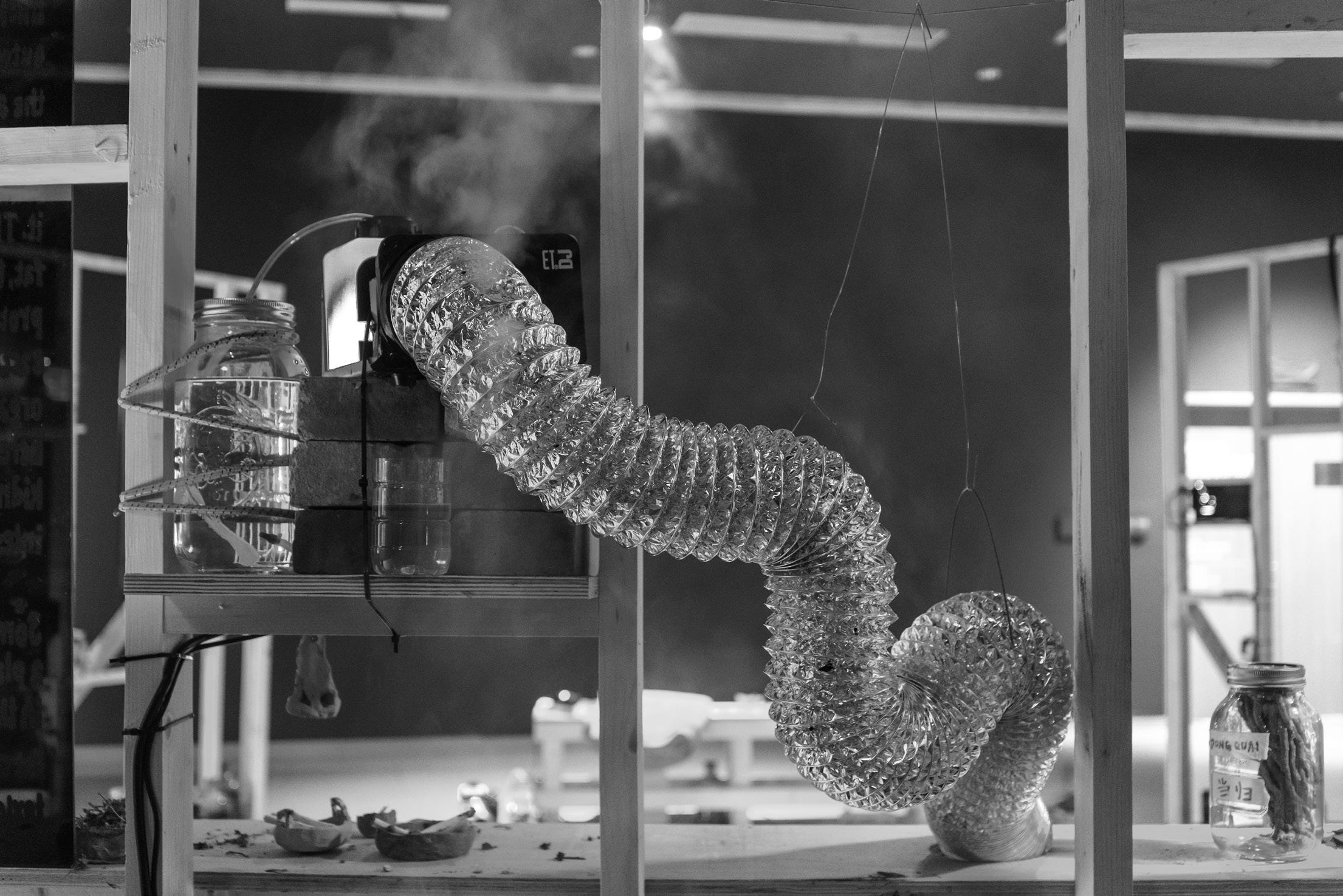
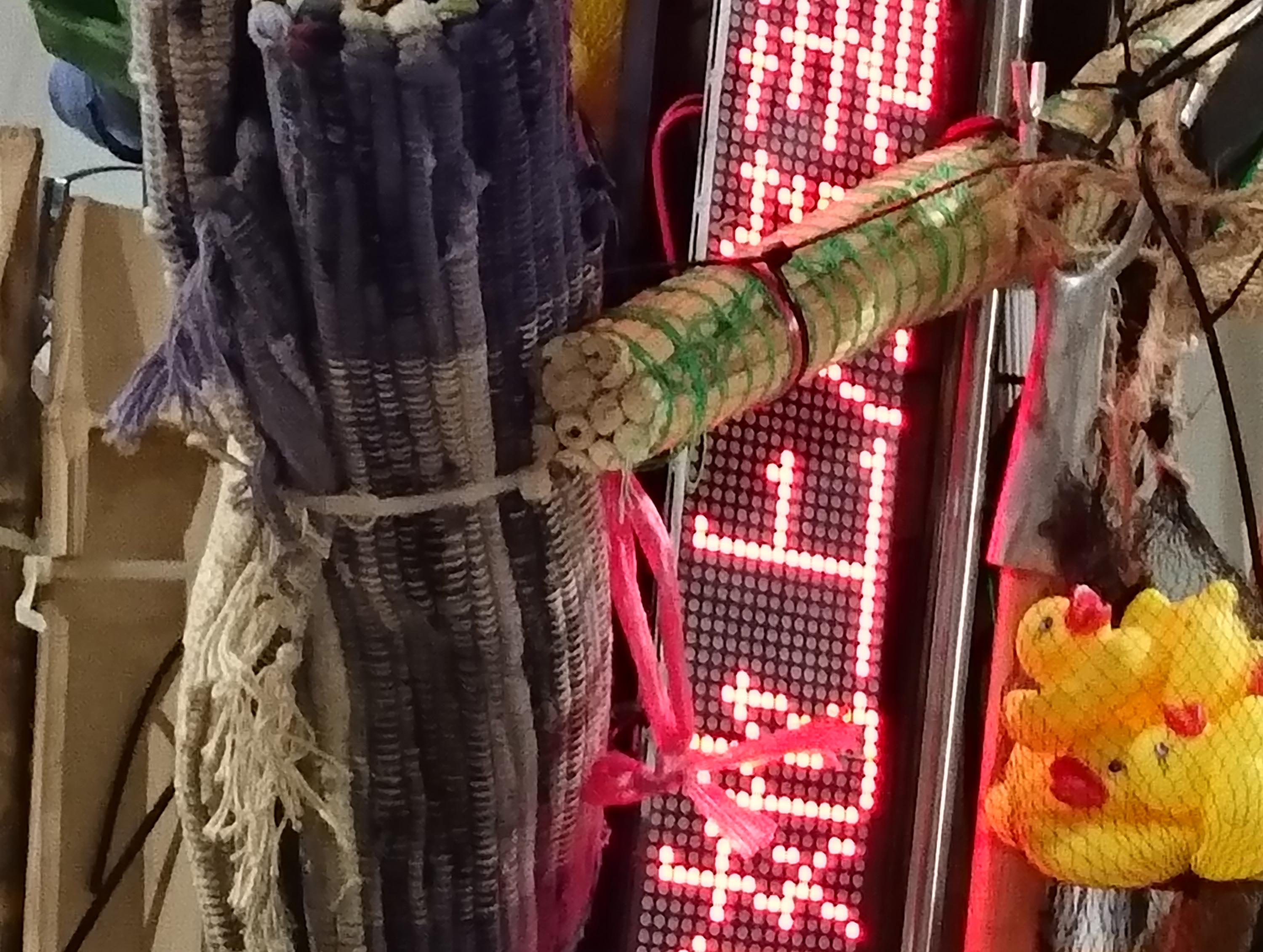



 Christine Sun Kim
Christine Sun Kim













 Mika Tajima
Mika Tajima







